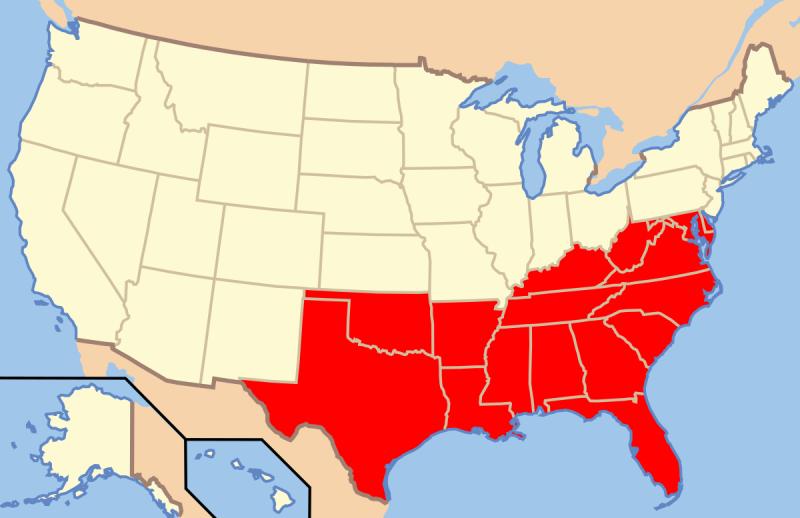New data show six Southern states now contribute more to GDP than the entire Northeast



Liberalshave long bragged that blue states are the ones primarily responsible for the U.S.'s great economy and rising GDP.
But new data suggest that's changing. According to a report from Bloomberg, "For the first time, six fast-growing states in the South — Florida, Texas, Georgia, the Carolinas and Tennessee — are contributing more to the national GDP than the Northeast, with its Washington-New York-Boston corridor." This initially became true in 2021, but the gap between these states and the Northeast has expanded over the past year.
Today, those six Southern states contribute 1.4 percentage points more to the GDP than the entire Northeast.
Among the main reasons for this is the massive migration from major cities in the Northeast, such as New York and Washington, D.C., to the South. Internal Revenue Service data show that interstate migration "helped steer about $100 billion in new income to the Southeast in 2020 and 2021 alone, while the Northeast bled out about $60 billion."
This is consistent with data published yearly by the National Association of Realtors, which show that 5 out of the 10 states with the most out-migration in 2022 were in the Northeast, with New York losing almost 300,000 people last year. On the other hand, the top six states with the most in-migration were all in the South: Florida, Texas, the Carolinas, Tennessee, and Georgia.
But it's not just individuals who are fleeing for red states in the South. Bloomberg reports that, according to census data, "Corporations are also flocking there, with a record number of firms moving south after the pandemic."
Bloomberg partly attributes the significant migration to the South to "the warmer weather, lower taxes, looser regulation and cheaper housing." The data back this up. However, it says there is an added factor that is hard to quantify, as it is about the atmosphere in the South that makes individuals and businesses alike feel wanted.
"We now have more employees in Texas than New York state. It shouldn't have been that way," said JPMorgan Chase CEO Jamie Dimon.
For those who have been tracking population shifts over time, this should not come as too much of a surprise. However, if one had only been listening to the corporate press over the past few years, one could easily be shocked. After all, news coverage on Florida, Texas, and Tennessee has painted them as dystopian hotbeds of bigotry and authoritarianism where students aren't allowed to read books and minorities must be in constant fear.
The issue, of course, is that caricature couldn't be further from the truth. We know this because of the facts. But we also know it because people ultimately vote with their feet. There is a reason why so many people are moving to these red states despite the slanted news coverage. Similarly, despite the terrible things some people say about the U.S., there is a reason millions of people would literally risk death to come here. Rhetoric is cheap. People act based on conditions in the real world.
It is a great thing that a region of the country historically not known to be an economic powerhouse has now turned the tide. Maybe more liberals will now refrain from making snarky comments about how their states are the ones actually contributing and instead focus on fixing the problems that incentivized so many people to flee.






That’s really rough as that region also has high state/local debt per capita. NY, CT. and MA are at 1, 2 and 3 respectfully. RI is 11th, NJ 14th and PA 15th.
Good. It's about time they supported themselves.
I hate these articles because it always seems like an exercise in lying with statistics. That's why I tend to attack them. Thus:
For the first time. In almost 250 years, it's the first time. Wow. I mean, good for them, I guess - but wow.
The choices for this collection are strange, though. The report cherry picks the 6 most productive southern states, which are not actually connected physically.
But then it takes the Northeast as a physical mass, irrespective of actual economic connection. By that I mean, why would you include Vermont? Vermont literally has the lowest GDP in the country. You don't choose Mississippi to represent the South, but you choose Vermont to represent the North.
For that matter, why choose New Hampshire? Maine? These places are basically "The Woods," - not places traditionally known for economic productivity.
Since we're cherry picking, if you can reach out from the Southeast to include Texas, why can't you include Illinois or Ohio for the North? Those states are far more traditional economic engines. Illinois produces more GDP than every state in this study except Texas, and Florida - with Ohio right behind Florida. You swap out Maine, New Hampshire, and Vermont for Illinois and Ohio, and the results of this "study" are moot.
If your perspective is even less regional and more about public policy, why not include California?
Anyway, looking at the states they chose, those six southern states have a population of 84.9 million people. The northeast states have a population of 65 million people. So if population is our foundational metric (this article is all about migration), those southern states should produce more GDP. Way more. Like in the neighborhood of 25% more, not 1.4% more.
Again, it's about time. We should see more of this, though, especially as it becomes easier to do so much business at a distance.
Yeah, never discount the weather. There's a reason that California, Florida, and Texas have the highest state populations, and I'm not thinking of public policy, which obviously varies among these states. It's the weather - and beaches. Snow is charming in Hallmark Christmas movies or on vacation, but living with it all winter, year after year, sucks - especially if there is an easy fix. If your industry can exist away from the Northeast, I don't know why anyone would choose to live there.
Wasn't GDP in 1860, 160 years ago, higher in the South?
Yeah, I don't know. This is the one stat I didn't actually Google. I'm taking the writers of the article at their word.
I have a feeling that actually researching the GDP of all these states . . . by year . . . going back to 1860, would probably take me days - if the data is even out there.
Yeah, I found that to be a little unbelievable as well. Prior to the Industrial Revolution the USA was much more of a Agrarian economy.
Before 1862, cotton was king.
I don't think it was, or even particularly close. The south pushed the narrative of how important cotton was to the economy, but it really wasn't as the North's prosperity throughout the civil war demonstrated.
In 1860, 5 of the 10 wealthiest states in the US were southern states; 6 of the top 10 in per capita wealth; calculated just by white population, 8 of 10. As a separate nation in 1860, the South by itself would have been the world's 4th wealthiest, ahead of everyone in Europe but England.
I guess it depends what your source is. Cotton was six percent of the American economy in 1860. I think the ultimate proof of how little it mattered was how well the American economy thrived despite it being totally removed. King Cotton was supposed to create an economic Armageddon when it was cutoff. It was barley a blip.
Yes, and your metrics. In 1860, cotton accounted for almost 60% of American exports, representing a total value $200M per year.
60% of exports does not equal 60% of GDP but something less.
Probably less back then than it is now which is about 11%.
Actually 5 of the 6 are connected physically, not really sure why that matters to you but... you're right that the Lone Star state shines all on its own!
It obviously mattered to the authors. Why did they pick those 6 Southern states? Because they supported a narrative. Why did they pick the Northern states they chose? Again, because it benefitted the narrative.
The economic engine of the North has always gone East to West, from Massachusetts and New York through Pennsylvania and Ohio, to Illinois. Maine, New Hampshire, and Vermont are not part of that.
And if you're trying to say that the public policy of conservative states is superior economically to that of liberal states, then it's dishonest to ignore Illinois and California.
Really #29 and 39?
Aren’t both high in state/local debt as their populations shrink?
What is this garbage? Utah is the best economy in the country? Do you know how full of shit US News is? Do you know how hated and derided their lists are?
This article is about GDP - something you can actually measure. California, by far, contributes more to the national GDP than any other state. It's currently about 14.5%. Even New York and Texas are only 8-something% each. California is the 5th largest economy in the world. Get that US News shit out of here.
Before you call it garbage, perhaps you should understand the methodology used.
A methodology much more detailed and involved than just GDP size.
Much more
There's no reason to get upset that California is on a downward spiral... unless you're one of the ones that stayed.
Their methodology is 1) bullshit, and 2) irrelevant to this seed.
Where do you get from what I wrote that I’m upset? How is being the 5th largest economy in the world (when in previous years, it was only 6th, 7th, 8th, etc.) a downward spiral?
Perhaps but what is even worse bullshit is basing it on state GDP only. Complete and utter bullshit.
lol …you’re the one bringing up states, population, gdp, etc and now this study is irrelevant? C’mon man, you’re better than that.
Please... perhaps because those 6 southern states are outperforming the entire Northeast,....
Please see:
Circular Reasoning
So the article asserts that it is significant that 6 states in the South are - marginally - outperforming the Northeast.
I ask why they chose those particular states (both the choices for the South and the Northeast) instead of others, and your response is that it’s because the Southern states chosen are outperforming the states chosen in the Northeast.
Seem circular to you? It sure does to me. It’s also pretty useless.